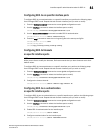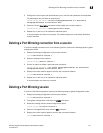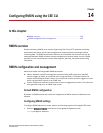
Dell Converged Enhanced Ethernet Administrator’s Guide 119
53-1002116-01
Chapter
13
Configuring Port Mirroring using the CEE CLI
In this chapter
•Port Mirroring protocol overview. . . . . . . . . . . . . . . . . . . . . . . . . . . . . . . . . . 119
•Configuring ingress Port Mirroring . . . . . . . . . . . . . . . . . . . . . . . . . . . . . . . . 120
•Configuring egress Port Mirroring. . . . . . . . . . . . . . . . . . . . . . . . . . . . . . . . . 120
•Configuring bidirectional Port Mirroring. . . . . . . . . . . . . . . . . . . . . . . . . . . . 120
•Deleting a Port Mirroring connection from a session . . . . . . . . . . . . . . . . . 121
•Deleting a Port Mirroring session . . . . . . . . . . . . . . . . . . . . . . . . . . . . . . . . . 121
Port Mirroring protocol overview
Port Mirroring is used on a network switch to send a copy of network packets seen on one switch
port to a network monitoring connection on another switch port. If you are interested in listening or
snooping on traffic that passes through a particular port, Port Mirroring artificially copies the
packets to a port connected to your analyzer. Usually, this traffic is limited to incoming or outgoing
packets, but Fabric OS v6.3.1_cee allows bidirectional traffic monitoring on the source port.
Port Mirroring limitations
The limitations of Port Mirroring connections are as follows:
• Mirror port can be any port on the same switch as the source port.
• Mirror port should not be configured to carry normal traffic.
• A port can not be mirrored to multiple locations in the same direction.
• A BP port is not supported as a source or destination mirror port, because this interface is not
exposed to the user.
• Only one port per chip can be configured as a destination port for ingress mirroring.
• Only one port per chip can be configured as a destination port for egress mirroring.
• A port cannot be made a destination port for bi-directional mirroring if a different port on that
chip is already configured as destination port for any type of mirroring.
• If a port is configured as a destination port of bi-directional mirroring, no other port on that
chip can be made destination port for any type of mirroring.
• The destination mirror port can only handle 10G (line rate) worth of mirror traffic. If multiple
ports, or both flows on same port, are mirrored to the same destination mirror port, then only
10G worth of mirror traffic is mirrored and the remaining traffic is ignored.
• If multiple ports (or both flows on same port) are mirrored to the same destination port, and
two or more ports process burst traffic, the destination mirror port cannot handle all the bursts
and some of the burst traffic is not mirrored.


















